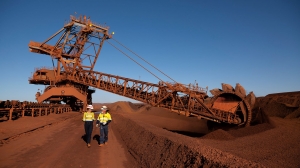


(Posted on 02/11/22)
Global miners BHP and Rio Tinto have formed a partnership agreement to accelerate the development of technology that could significantly increase water recovery from mine tailings, and in turn reduce potential safety risks and environmental footprints associated with tailings storage facilities.
The first project will involve testing the application of an innovative large-volume filter unit at a BHP copper mine in Chile, which would remove up to 80% of the water in the tailings stream before it is deposited in a storage facility.
Rio Tinto will bring its experience from implementing smaller-scale tailings filters for bauxite residues at alumina refineries since 2005. Both organisations will work in collaboration with leading technology and equipment providers, technical experts, research groups and the academic sector.
Manufacture of the filter unit is already underway. The pilot construction is due to begin in early 2023 and operations are scheduled to commence in early 2024. The pilot will test the potential of a large-scale tailings filter unit for scalability and cost-effectiveness across global mining operations.
Removing more water from tailings would reduce potential risks associated with moisture in storage facilities, reduce the footprint required by such facilities, and create opportunities to productively re-use tailings, for example, as raw material for glass, construction or agriculture industries.
The additional water recovered from tailings by filtration could be re-used in processing facilities, reducing overall water consumption.
BHP Chief Technical Officer, Laura Tyler, said: “The world will need more critical minerals in the decades to come to support economic development and decarbonisation pathways. It is important that we keep working together across the global mining sector to raise standards and make sure our operations are as safe and sustainable as they can be. Responsible management of tailings and improved water use is a big part of that.”
Rio Tinto Chief Technical Officer, Mark Davies, said: “It is in everyone’s interest that we, as an industry, find safer and more sustainable ways to manage tailings. As two of the leading companies in the sector, we want to bring our combined knowledge and expertise to address this challenge.”
Tailings usually takes the form of a liquid slurry made of fine metal or mineral particles and water – created when mined ore is crushed and finely ground in a milling process to enable the metals and minerals of interest to be extracted.
ADM and Mitsubishi Corporation have signed a non-binding memorandum of understanding to form a strategic... Read more
ESL Shipping and global steel manufacturer SSAB have agreed on a multi-year extension of the agreement... Read more
Anglo American’s Sakatti copper and polymetallic project in Finland has been designated as a &... Read more
FEFAC, representing the EU compound feed and premix manufacturers, noted with deep concern the announced... Read more
Catering to the growing demand from India’s confectionery, infant formula, and dairy sectors,... Read more
Khalifa Economic Zones Abu Dhabi – KEZAD Group, the largest operator of integrated and purpose... Read more
Rio Tinto will invest $1.8 billion1 to develop the Brockman Syncline 1 mine project (BS1), extending... Read more
Catherine Cobden, President and CEO of the Canadian Steel Producers Association (CSPA), has released... Read more
Enough domestic ferrous scrap is available for electric arc furnace (EAF) steelmakers to supply nearly... Read more
Cargill’s Ocean Transportation business and leading tanker shipping company, Hafnia, have joined... Read more